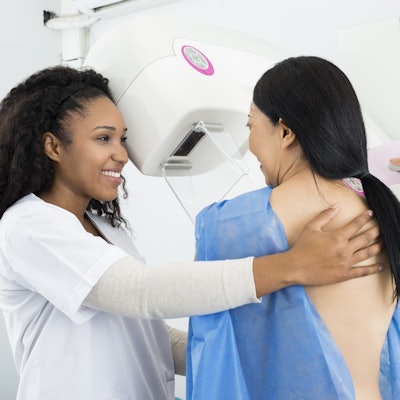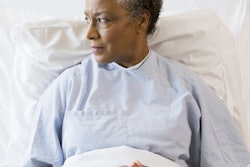
In the last 10 years, we have witnessed growing negativity regarding mammography screening. Numerous myths have sprung up about mammography, its effectiveness, and its potential complications, such as overdiagnosis.
These unfortunate attitudes appear to be associated with the U.S. Preventive Services Task Force's (USPSTF) revision of mammography screening recommendations -- no longer recommending mammography screening for women ages 40 to 49.
History of the USPSTF's decision in 2009
 Dr. Matt Dyson.
Dr. Matt Dyson.The USPSTF is a volunteer group of independent medical experts with preventive services expertise. Its primary task is making recommendations regarding screening tests, medications, and counseling services to prevent diseases. The USPSTF is funded by the U.S. Department of Health and Human Services; however, it makes its decisions independently.
In 2002, the USPSTF advised that women should begin mammography at age 40 -- however, this guidance was never formalized. In 2007, a new board evaluated five-year data to compare both new and old results. These evaluations led to the formulation of new modeling, leading to the 2009 mammography recommendation updates, which removed the recommendation that women in their 40s undergo regular breast screening.
Loud outcries erupted over the 2009 mammography policy changes. Emotions ran high among healthcare professionals, including the American College of Radiology, which proclaimed, "Two decades of decline in breast cancer mortality could be reversed, and countless American women may die needlessly from breast cancer each year."
Politics became involved, too, as politicians wrangled over mammography and the Patient Protection and Affordable Care Act. Concern rose over medical rationing. Sen. Tom Coburn of Oklahoma, a physician, wrote an editorial for the Wall Street Journal, talking about a 33-year-old patient who developed breast cancer. Rep. John Shadegg of Arizona warned about the consequences of the new USPSTF mammogram policy. Rep. Frank Pallone Jr. called for hearings on the USPSTF new recommendations on breast cancer screenings.
In the end, the Senate voted 61 to 39 to guarantee coverage for mammography.
Yet, the damage had been done with conversations about "overdiagnosis." Some studies stated that "mammograms pick up cancers that don't need to be found." Costs crept into the controversy with conversations about screening costs to save just one life. Concern over rationing health screening became an issue. Fears of overtreatment surfaced.
Even conflict of interest concerns appeared, further polarizing proponents and opponents of the USPSTF change in recommendations.
Mammography and breast cancer in 2020
Since 2010, the percentage of women having a mammogram has been decreasing. According to a Kaiser Family Foundation study, only 72% of women over 40 had a mammogram within the last two years between 2016 and 2018. The average size of tumors in the newly diagnosed has crept back over 2 cm. The myth that "mammography does more harm than good" continues to perpetuate itself.
Many mammograms have been postponed or canceled due to the COVID-19 pandemic. Numerous women are afraid to go to in-person medical appointments and have delayed their annual mammogram well into 2021 or beyond.
Ways to overcome the antimammography movement
One of the most effective ways to overcome the antimammography movement is by providing accurate and factual data. Be proactive when talking to patients. Talk to them about their fears and objections to having annual mammograms. Empathy goes a long way in overcoming patients' objections.
Learning why a patient is delaying or avoiding her mammogram is the first step in enabling her to schedule and keep her mammogram appointment. Some objections can be more easily addressed than others. Here are some of the objections that patients may offer:
- Fear of the unknown (i.e., first mammogram): Reassure patients about their first mammogram. Take a few minutes to explain the procedure so they know what to expect during the exam and how they will be notified of the results.
- Pain during the mammogram: Don't belittle or degrade a woman who experienced pain during mammography. Their mammogram might have occurred just before their period when breasts are most tender and sensitive. Suggest that scheduling a week after their period and avoiding caffeine for 24 hours before their mammogram may lessen the chance of discomfort.
- Fear of excessive radiation exposure: Reassure patients that the risk of excessive radiation is virtually nonexistent. Every person in the U.S. is exposed to "background" radiation from their surroundings -- about 3 mSv annually. A mammogram is the equivalent of seven weeks of background radiation.
- Fear of the results: Detecting cancer is the goal of annual mammography so that treatment will be successful. Women without insurance may defer mammography because they don't have the financial means to get treatment. Reassure patients that you've had other patients in their situation and that financial aid is available to help uninsured patients.
- False positives: Remind patients that the purpose of mammography is to find abnormalities in the breast tissue. Just because we find a suspicious-looking area doesn't mean that it's cancer. We may ask the patient to come in for some additional views. If there is still an area of concern, a biopsy may be required. Only about 20% of breast biopsies are positive for cancer. We compare next year's mammogram with the previous one to help prevent additional testing.
- Overtreatment: While we cannot predict if early-stage cancer will be aggressive, we would be doing a disservice to our patients if we did not provide annual mammography beginning at age 40. Despite mammography's limitations, it is the best screening tool for women's most common cancer (except skin cancer). One out of every eight women in the U.S. will be diagnosed with invasive breast cancer in her lifetime.
- Fear of thyroid cancer: The American Thyroid Association's research shows that the recent increase in thyroid cancer diagnoses is not related to mammograms, dental x-rays, or chest x-rays.
- USPSTF guidelines: Not even one of the taskforce members who recommended the changes for timing and frequency of mammography in 2009 had experience in the diagnosis or treatment of breast cancer. The institutions involved in breast cancer diagnosis and treatment recommend that women have their first mammogram at age 40 (or earlier if they are at increased risk) and continue having mammograms annually.
You and your staff can make a difference. Empathy, kindness, enhanced patient education, and a dose of good old "bedside manner" will help your patients overcome the negativity sometimes associated with mammography.
Dr. Matt Dyson is a diagnostic radiologist with Catawba Radiology of Hickory, NC. He is fellowship-trained in breast Imaging with a special interest in mammography and breast biopsy.
The comments and observations expressed are those of the author and do not necessarily reflect the opinions of AuntMinnie.com.



















